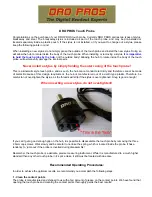
WHAT COULD HAPPEN HOW TO PREVENT IT
WA R N I N G
INHALATION HAZARD
Always wear properly fitting facemask
or respirator when using such tools.
Always work in a clean, dry,
well-ventilated area.
WHAT COULD HAPPEN HOW TO PREVENT IT
WA R N I N G
RISK OF INJURY
A tool left unattended, or with the air
hose attached, can be activated by
unauthorized persons leading to
their injury or injury to others.
Air tools can propel fasteners or other
materials throughout the work area.
A wrench or a key that is left attached to
a rotating part of the tool increases the
risk of personal injury.
Using inflator nozzles for duster
applications can cause serious injury.
Air tools can become activated by
accident during maintenance or tool
changes.
Air tools can cause the workpiece to
move upon contact, leading to injury.
Remove air hose when tool is not in
use and store tool in secure location
away from reach of children and
untrained users.
Use only parts, fasteners and accessories
recommended by the manufacturer.
Keep work area clean and free of
clutter. Keep children and others away
from tool while it is in operation.
Keep work area well lit.
Remove adjusting keys and wrenches
before turning the tool on.
DO NOT
use inflator nozzles for duster
applications.
Remove air hose to lubricate or add
grinding attachments, impact sockets,
chisels, etc. to the tool.
Never carry the tool by hose.
Avoid unintentional starting. Don't carry
hooked-up tool with finger on trigger.
Only an authorized service
representative should do repair servicing.
Use clamps or other devices to prevent
movement.
5
Abrasive tools, such as grinders,
sanders and cut-off tools generate dust
and abrasive materials, which can be
harmful to human lungs and respiratory
system.
Some materials such as adhesives and
tar contain chemicals whose vapors
could cause serious injury with
prolonged exposure.






































